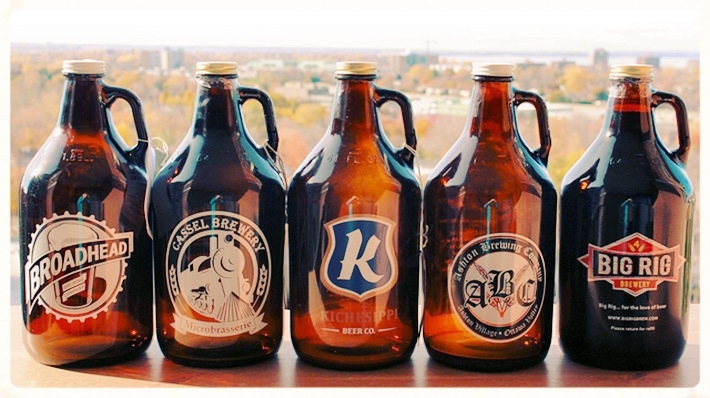
Now what to do with those growlers?
By Katy Watts
I have a love/hate relationship with growlers. Superficially I love the idea – a 1.89 litre jug of fresh beer, usually something special, bought direct from the source. But, when I look deeper, or when I’m stuck with an aging growler on a Wednesday, it may not be the most sensible beer delivery option.
Don’t get me wrong, I love supporting my local brewery and from the look of my 15th floor apartment balcony where I store all of my empty growlers (I refer to it as my Growler Graveyard) I also like supporting breweries from Toronto, Vermont, New York, even Utah. Which is one of the problems! What do I do with all of these empty jugs?
I can’t return them to the brewery (too far!), I can’t bring them to an Ottawa brewery to be refilled due to Alcohol and Gaming Commission of Ontario (AGCO) regulations, but because I’ve now invested $4 or $5 in each jug, I have a strange financial attachment to them. Maybe when the balcony reaches capacity I’ll start making growler lights or take up a new instrument – the growler xylophone. Oh well, at least the beer’s good, right?
 Or is it? Yes, as mentioned growlers are filled fresh from the source sometimes right before your eyes, but sometimes that can have an effect on the taste. There are two methods of filling growlers, the down and dirty way where a hose is attached to a draught tap and the growler is filled till it overflows and sealed. Easy to do, low overhead for the brewery or brewpub, but by exposing the beer to oxygen it starts deteriorating immediately and has a limited lifespan of 3-4 days.
Or is it? Yes, as mentioned growlers are filled fresh from the source sometimes right before your eyes, but sometimes that can have an effect on the taste. There are two methods of filling growlers, the down and dirty way where a hose is attached to a draught tap and the growler is filled till it overflows and sealed. Easy to do, low overhead for the brewery or brewpub, but by exposing the beer to oxygen it starts deteriorating immediately and has a limited lifespan of 3-4 days.
The other way of filling growlers uses the super cool PEGAS CrafTap system (or something similar) that creates a seal around the bottle, flushes evil beer eating oxygen and then fills from the bottom up (similar to a bottling line). Growlers filled with this system can last considerably longer – two to three months!
Finally, there’s the size. Here’s where I admit how much I drink; thankfully my Mom no longer reads my writing – she’s learned. While I admit I do enjoy a pint or two most nights, 1.89 litres (just over 3 imperial pints) is far too much for any night (unless I’m entertaining, then 1.89 litres isn’t enough) and when a growler is opened and its contents are exposed to oxygen it quickly starts to lose its carbonation. That means that if you’re trying to be sensible and put the rest of your growler in the fridge after pouring yourself a pint you’ll have less than stellar beer the next day. More and more breweries are offering the 1 litre size, also called ‘boston rounds’ (just under 2 imperial pints), in addition to the standard 1.89 litre, that’s a little more manageable.
As much as I hate having my neighbours judge me for my Growler Graveyard; cost, beer availability (especially if there are draught only releases) and beer tourism will always have me adding to my collection. Recently I bought a stainless steel growler that I pack when I’m travelling to provinces and states that allow you to fill your own growler. It keeps the beer costs even lower, but keeping it sanitized and dent-free can be a challenge. No matter what my feelings may be, it seems that growlers are here to stay as a convenient way to transport beer; I guess I’ll have to start practising my xylophone.
Stay tuned for more craft beer blogs each month.







